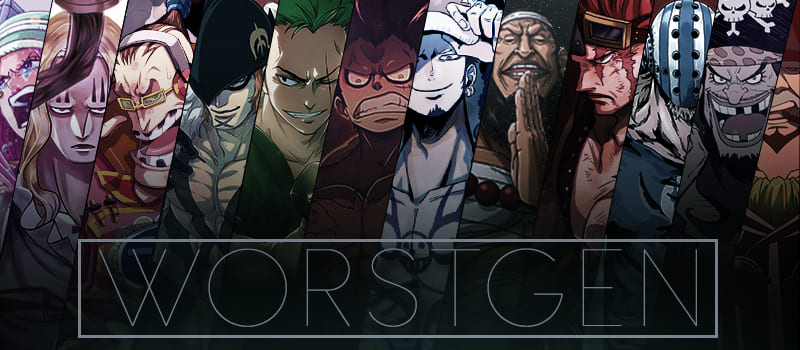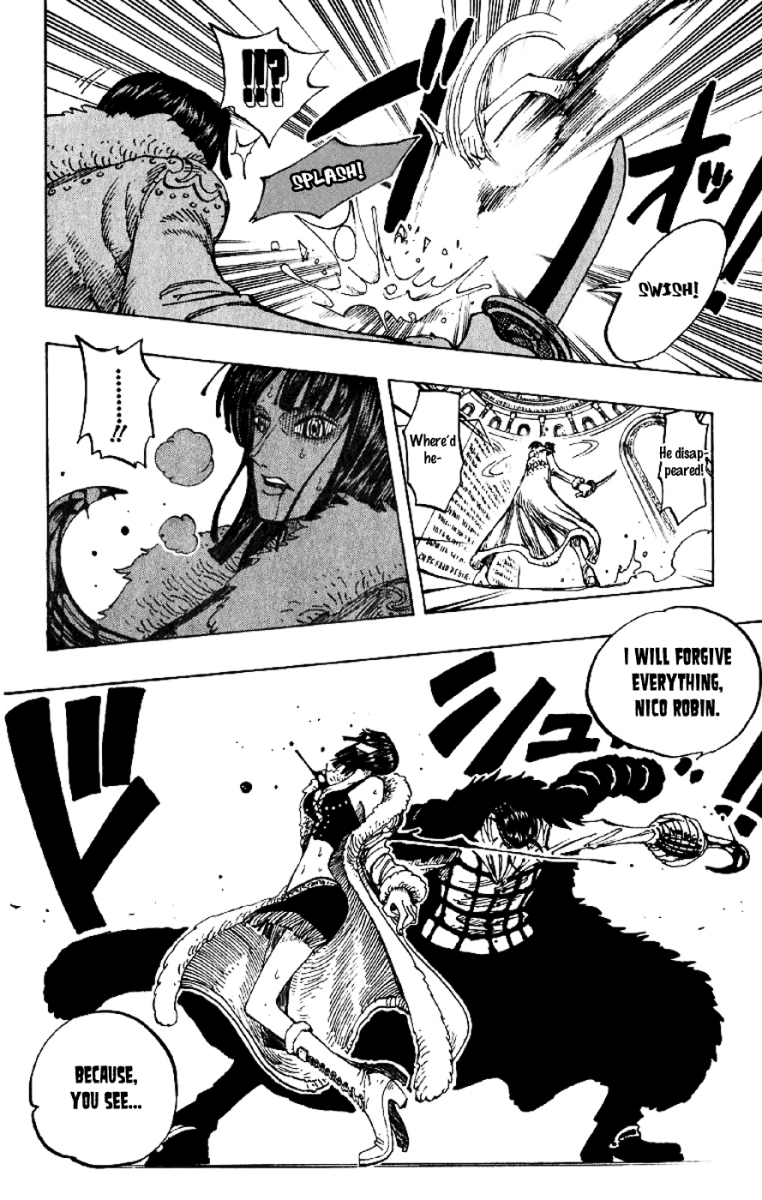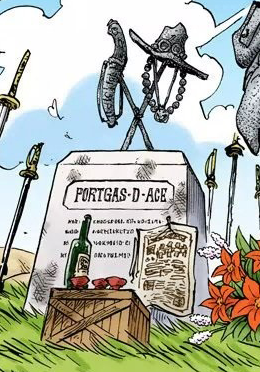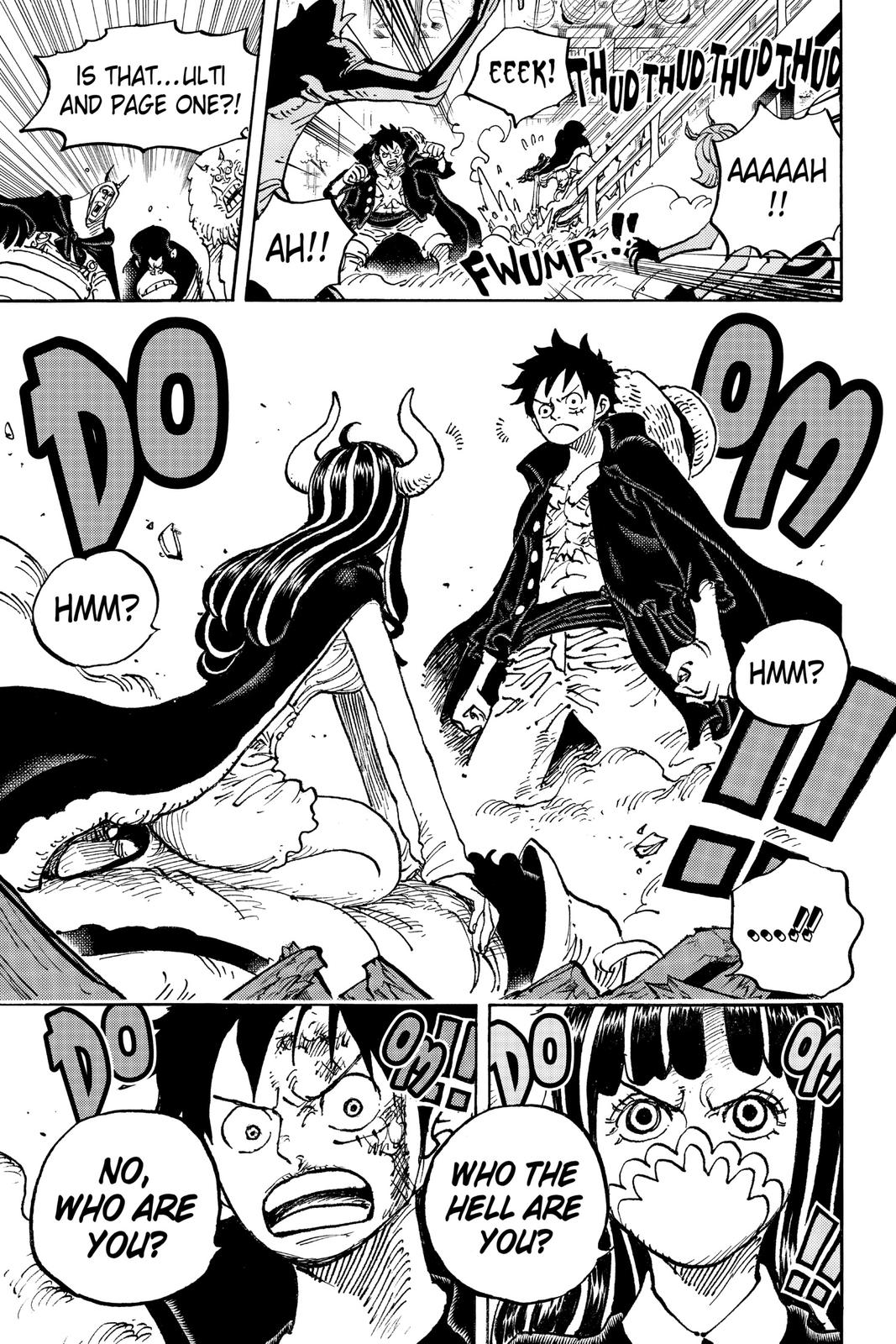It's no secret that I, the guy with young Monet as his icon, am a huge proponent of the theory that Monet is alive. While I've written an entire book on the subject, only a small part of said book covers how she survived. Seeing as the whole theory ultimately hinges on whether or not she's alive, there's really only one piece of evidence that would need to be refuted to suggest that she is in fact dead: her heart being intact when Franky finds Caesar passed out on the dock.
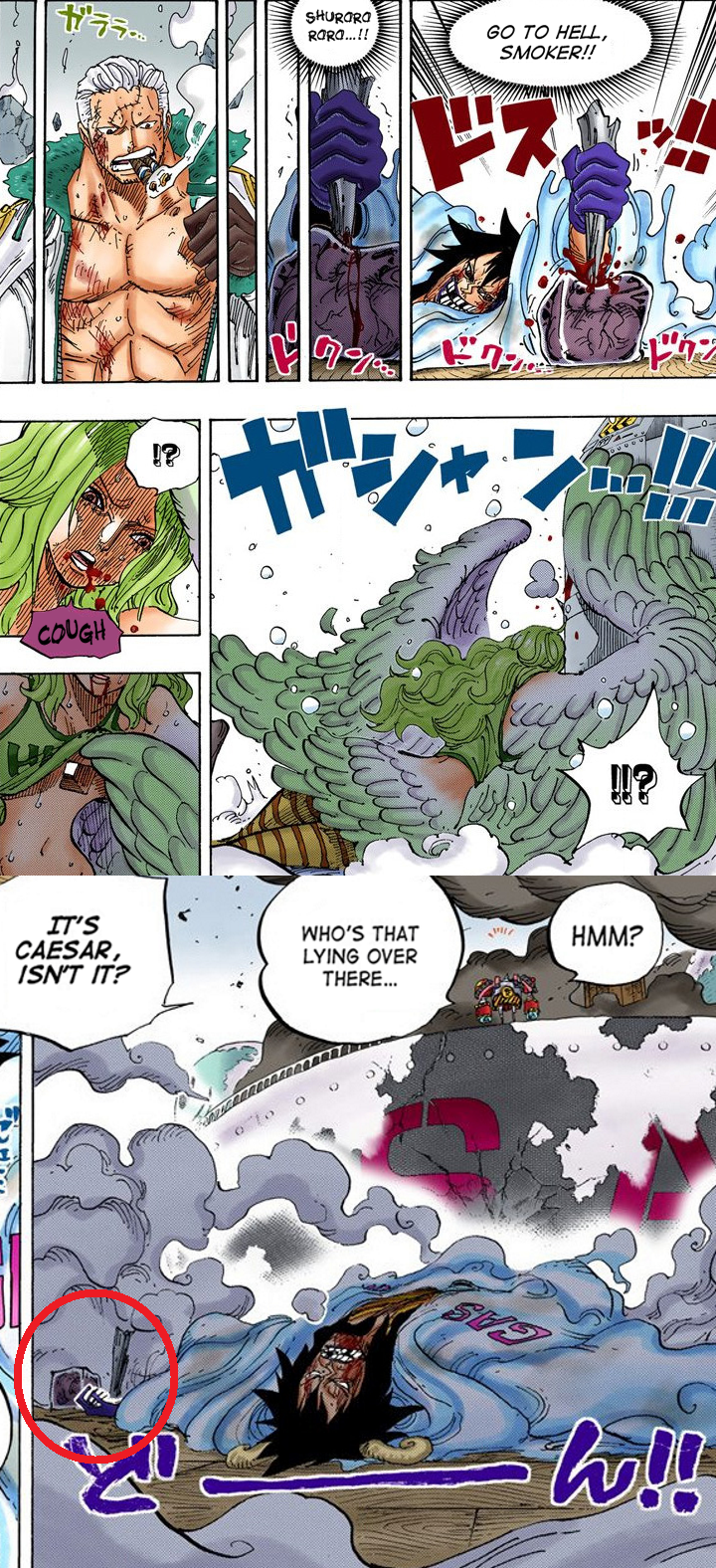
Despite Caesar clearly making contact with the piece of shrapnel and causing Monet's heart to bleed, in turn causing her to cough up blood and collapse, the shrapnel is also clearly depicted a little ways away from the heart and embedded in the dock. To me, and to many others, this suggests that Caesar's hand slipped as he fell unconscious, so while he was able to deal a hard enough blow to knock Monet out (like he did to Law earlier in the arc), he was not in fact able to pierce the heart and thus did not land a fatal blow.
No one I've ever spoken to has given me a satisfactory alternative explanation. The closest I've heard is that she still bled out and died from the wound she did receive, but if Oda was just going to kill her anyway, why didn't he just draw the shrapnel in the heart like we would expect it to be?
If Oda's intention is for her to be dead, why do you believe he drew the heart and shrapnel separately?
For the sake of concision, I'm going to be adding my rebuttals for opposing viewpoints to this post even if I've already addressed them directly in the thread. My hope is that we can, as a group, eliminate the possibilities and either arrive at a consensus that we can all be satisfied with or come to an understanding as to why we are on opposing sides of the issue in the first place.

Despite Caesar clearly making contact with the piece of shrapnel and causing Monet's heart to bleed, in turn causing her to cough up blood and collapse, the shrapnel is also clearly depicted a little ways away from the heart and embedded in the dock. To me, and to many others, this suggests that Caesar's hand slipped as he fell unconscious, so while he was able to deal a hard enough blow to knock Monet out (like he did to Law earlier in the arc), he was not in fact able to pierce the heart and thus did not land a fatal blow.
No one I've ever spoken to has given me a satisfactory alternative explanation. The closest I've heard is that she still bled out and died from the wound she did receive, but if Oda was just going to kill her anyway, why didn't he just draw the shrapnel in the heart like we would expect it to be?
If Oda's intention is for her to be dead, why do you believe he drew the heart and shrapnel separately?
For the sake of concision, I'm going to be adding my rebuttals for opposing viewpoints to this post even if I've already addressed them directly in the thread. My hope is that we can, as a group, eliminate the possibilities and either arrive at a consensus that we can all be satisfied with or come to an understanding as to why we are on opposing sides of the issue in the first place.
@Yasheen and @Chrono both suggested that Oda wanted to avoid depicting Monet being brutalized, the former suggesting it's because she was a minor character and the latter because she is a woman. In an act of self-censorship, Oda drew the shrapnel separately from the heart because that image would be uncomfortable either for him or the audience, but the stab either still killed her or she died later of other causes.
I definitely see the logic here, as it makes it clear that the heart's condition was an artistic choice on Oda's part and lines up with other similar choices he's made in the past. However, I feel that there are several reasons this is not likely to be the case.
1. The stab itself was much more brutal
I have a difficult time imagining something more brutal in the context of One Piece than a close-up on a disembodied heart being stabbed and blood spurting from it. This is the closest that I think Oda ever has or will get to depicting full-on gore, so I'm not too sure that showing that same heart with the shrapnel still embedded in it from a distance would be too much worse.
2. Oda has shown similarly brutal scenes in the past.
As @Flagandhat pointed out, Caesar stabbing Monet's heart is reminiscent of Crocodile stabbing Robin in Alabasta.

Based on the framing of the panel, I can see how one might say that Oda doesn't like to depict women being brutalized, but the image itself is still quite explicit. It may be subjective, but I would say that what happened to Monet is far more brutal for the reasons I listed earlier.
One might also suggest that this is because Robin is a more important character than Monet, but bear in mind that at this point in the story, Robin was approximately as important as Monet was in Punk Hazard: the arc villain's henchwoman. We had no idea that she was going to be a main character, much less a recurring character past this moment. If we are going to argue that Oda doesn't brutalize minor characters, then we would have to conclude that Monet is intended to become a major character. That's not what we're talking about right now, but it's interesting to note.
3. Oda's artistic skill
As I pointed out before, when Oda drew Robin being stabbed he avoided depicting the wound itself, only showing that Crocodile's hook had blood on it. He also used a screentone to shadow the panel, helping to hide Robin's blood among the shading on the hook. Oda clearly knows how to draw around unsavory subject matter, so we can assume if he didn't want to show us the shrapnel sticking out of the heart, he could have easily found a way not to.
Just off the top of my head, he could have positioned the panel so that the heart was completely off-screen, only the edge of the heart was on-screen, or the heart was behind Caesar's unconscious body. There may be other ways to work around it, but the point remains that he depicted the heart and showed us that the shrapnel had been removed at some point without explanation.
Because we know that Oda is a skilled artist, we can assume that this was a deliberate choice and that he has an intended sequence of events for what happened after the initial stab. Though we can only guess at Oda's true intentions, we can conclude definitively that Caesar did not simply drop the shrapnel. Because it is clearly embedded into the dock, we can safely say this happened while Caesar was swinging it down to stab.
I personally can only see two ways this happened: either Caesar's hand slipped as I said earlier, or he was stabbing repeatedly and wildly.
As things stand, stabbing wildly is the only way I can possibly think to justify Monet still receiving a fatal wound rather than a glancing blow, but because Oda only showed one stab in the first place, I can't imagine why he would have Caesar performing more stabs only to have him slip. The only thing this accomplishes is misleading the audience into thinking that there's a way that Monet could have survived the stab. If there were other strong implications that Monet is alive, this could be taken as a red herring, but because there's no clear alternative for it to be distracting us from, it can only be either that Oda intended the stab itself to be a misdirect or that he made a mistake in how he depicted the stabbing. As we've established, Oda is detail-oriented and skilled at panel framing, so in my opinion, the latter cannot possibly be the case. If it were, that would be an extremely disillusioning revelation for Oda's storytelling, so unless you want to claim that One Piece is poorly written or drawn, I think we can rule this out as a possibility entirely.
I definitely see the logic here, as it makes it clear that the heart's condition was an artistic choice on Oda's part and lines up with other similar choices he's made in the past. However, I feel that there are several reasons this is not likely to be the case.
1. The stab itself was much more brutal
I have a difficult time imagining something more brutal in the context of One Piece than a close-up on a disembodied heart being stabbed and blood spurting from it. This is the closest that I think Oda ever has or will get to depicting full-on gore, so I'm not too sure that showing that same heart with the shrapnel still embedded in it from a distance would be too much worse.
2. Oda has shown similarly brutal scenes in the past.
As @Flagandhat pointed out, Caesar stabbing Monet's heart is reminiscent of Crocodile stabbing Robin in Alabasta.

Based on the framing of the panel, I can see how one might say that Oda doesn't like to depict women being brutalized, but the image itself is still quite explicit. It may be subjective, but I would say that what happened to Monet is far more brutal for the reasons I listed earlier.
One might also suggest that this is because Robin is a more important character than Monet, but bear in mind that at this point in the story, Robin was approximately as important as Monet was in Punk Hazard: the arc villain's henchwoman. We had no idea that she was going to be a main character, much less a recurring character past this moment. If we are going to argue that Oda doesn't brutalize minor characters, then we would have to conclude that Monet is intended to become a major character. That's not what we're talking about right now, but it's interesting to note.
3. Oda's artistic skill
As I pointed out before, when Oda drew Robin being stabbed he avoided depicting the wound itself, only showing that Crocodile's hook had blood on it. He also used a screentone to shadow the panel, helping to hide Robin's blood among the shading on the hook. Oda clearly knows how to draw around unsavory subject matter, so we can assume if he didn't want to show us the shrapnel sticking out of the heart, he could have easily found a way not to.
Just off the top of my head, he could have positioned the panel so that the heart was completely off-screen, only the edge of the heart was on-screen, or the heart was behind Caesar's unconscious body. There may be other ways to work around it, but the point remains that he depicted the heart and showed us that the shrapnel had been removed at some point without explanation.
Because we know that Oda is a skilled artist, we can assume that this was a deliberate choice and that he has an intended sequence of events for what happened after the initial stab. Though we can only guess at Oda's true intentions, we can conclude definitively that Caesar did not simply drop the shrapnel. Because it is clearly embedded into the dock, we can safely say this happened while Caesar was swinging it down to stab.
I personally can only see two ways this happened: either Caesar's hand slipped as I said earlier, or he was stabbing repeatedly and wildly.
As things stand, stabbing wildly is the only way I can possibly think to justify Monet still receiving a fatal wound rather than a glancing blow, but because Oda only showed one stab in the first place, I can't imagine why he would have Caesar performing more stabs only to have him slip. The only thing this accomplishes is misleading the audience into thinking that there's a way that Monet could have survived the stab. If there were other strong implications that Monet is alive, this could be taken as a red herring, but because there's no clear alternative for it to be distracting us from, it can only be either that Oda intended the stab itself to be a misdirect or that he made a mistake in how he depicted the stabbing. As we've established, Oda is detail-oriented and skilled at panel framing, so in my opinion, the latter cannot possibly be the case. If it were, that would be an extremely disillusioning revelation for Oda's storytelling, so unless you want to claim that One Piece is poorly written or drawn, I think we can rule this out as a possibility entirely.
Yasheen also suggested that Monet was caught in an explosion after she collapsed in C Block, which she would have no way of surviving. While addressing this, I'm going to also address the general idea that anything other than the stab wound killed Monet, making the stabbing irrelevant.
The first big problem with this argument is that there was no explosion for her to be caught in, at least not as far as I could find. I'd love to provide visual proof, but that would require posting the entirety of Punk Hazard past Monet's supposed death and asking you all to comb through it. The closest I can provide is one of our last views of Punk Hazard: Brownbeard and his remaining crewmates reentering the lab to find his crewmates and the G-5 marines who were caught in the Shinokuni gas.
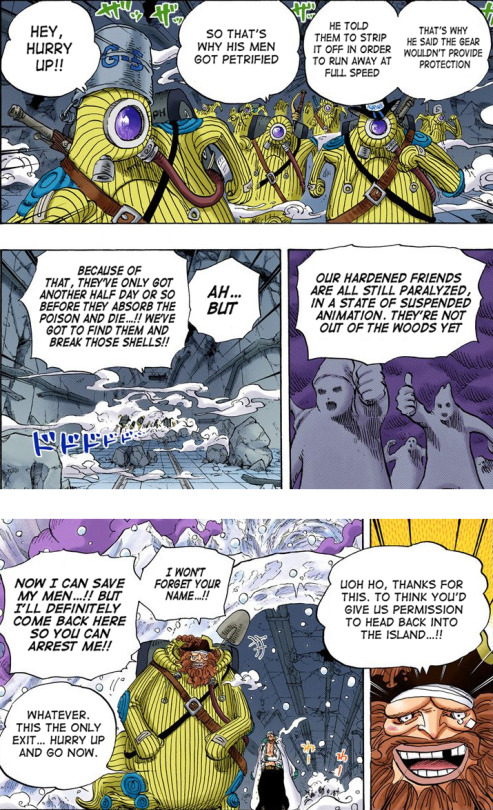
If there were an explosion that the unconscious Monet would have been unavoidably caught in, the petrified marines and pirates would certainly have been caught as well, killing them and giving Brownbeard no reason to go back to look for them.
I think that there are two points of confusion here that Yasheen may have been referring to, though they have not confirmed it for me at the time of this writing.
First, there was in fact an explosion during the Punk Hazard arc...moments before Monet was stabbed.

After defeating Vergo in the SAD production room, Law set the entirety of D Block to explode, presumably intending to kill Vergo. While explosions have been shown to be plenty survivable and Vergo may well be alive from this explosion, that is not the topic of discussion in this thread. The one person we can be absolutely survived this explosion is Monet, as she is clearly alive and commenting on the explosion in C Block.
Alternatively, they could be referring to a conversation in chapter 1007 where CP0 discusses an explosion on Punk Hazard.

Because of the vagueness of the dialogue, lots of people seem to have taken the conversation to mean that after the events of the Punk Hazard arc, an explosion occurred that did indeed wipe out Punk Hazard, but Caesar's lab somehow survived. However, based on the fact that G-5 made the report, we can assume that this is referring to the events that we witnessed firsthand ourselves during said arc.
Remember, the backstory for Punk Hazard was that it was a secret island used for testing weapons on pirates captured by the Marines run by Vegapunk. When Caesar tried to develop weapons of mass destruction that would incur civilian casualties, Vegapunk removed him from the research team, prompting Caesar to trigger an explosion that destroyed two of Punk Hazard's three labs and spread a highly toxic and paralytic gas through the island, making it uninhabitable.

The one lab that was still functioning under Caesar's command was discovered by Smoker and G-5, who then reported Caesar's operations to the World Government. The reason Caesar was able to continue his operations for so long was because the World Government thought all of Punk Hazard had been destroyed, which in turn is why Aokiji and Akainu had their battle there, thinking no one could possibly be caught in the crossfire.
Because the World Government didn't know that Punk Hazard still had an operational lab, CP0 didn't know, leading to the long-haired agent believing that all of Punk Hazard had been destroyed. After the events of the Punk Hazard arc, G-5 made their report which made its way to the hat-wearing agent, who revealed to the other two that Lab 3 was still operational and may have housed the cloned Fish-Fish Fruit, Model: Seiryu.
In short: there is no reason to assume that the CP0 conversation is referring to some explosion we've never heard of when there's a much more viable established explosion that they are likely talking about.
To cover all of my bases, Yasheen could also have been referring to the spread of Shinokuni, though I'm not sure why they would have referred to that as an explosion. Though we don't know what happened after the events of the arc just yet, we were explicitly shown that C Block, where Monet was, was sealed off from Shinokuni.
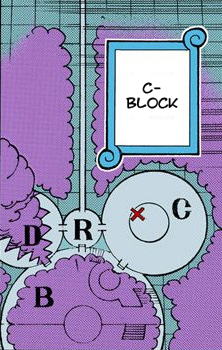
It's possible that Shinokuni leaked in later, but if that happened, there's a good chance that whatever allowed it to leak in also allowed Brownbeard and his crew to also enter C Block and find Monet. This might even be the explanation for how she got out of Punk Hazard without succumbing to Shinokuni: Brownbeard may have brought her to Smoker and had her treated and subsequently arrested. It's hard to say, and also again not the discussion at hand.
@Rootbeer suggested that because any blood came out of the heart at all, it must be damaged internally and Monet would die regardless of where the shrapnel ended up. Again though, One Piece has a well-established track record for even the most fatal injuries being survivable. I won't go into every single example as that would take far too long, but just to go through some of the most salient instances, we have: Robin suffering a similar wound as stated earlier; Law similarly surviving having his heart punched by Caesar which should also have caused internal damage since it results in him fainting and bleeding...
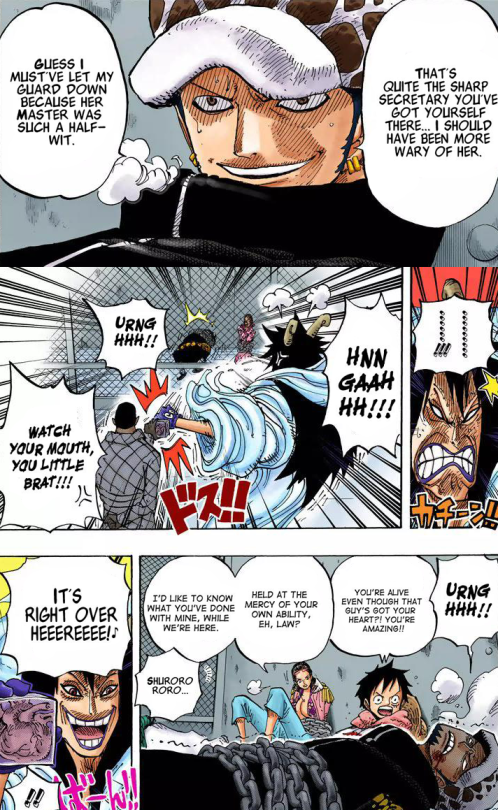
...Dalton receiving three ballista-sized arrows to the torso, likely piercing at least his lungs and possibly other major organs...

...and the single most ridiculous injury that anyone in One Piece has survived - Wapol having his head cut off only to be reattached with tin plates.

Wounds of similar and significantly greater fatality have been shown to be survivable within the context of One Piece's world with the barest of explanations if any at all. Why should we worry about a little bit of blood when so many other characters have simply shrugged off so much worse?
Ultimately, though, this argument itself doesn't carry much weight for one simple reason: Oda didn't need a secondary method for killing her. He already showed her heart being stabbed. If he wanted her dead, why wouldn't he just commit to the method that he showed us? Why would he leave a hint that she might be alive if he was just going to kill her with a different method anyway? It doesn't make any sense to kill her with an unknown and roundabout method after writing a workaround to the straightforward method he made an explicit show of. Again, this whole argument hinges on the assumption that Oda's writing is sloppy, this time in the sense that it's wildly overly complicated, which I don't think I need to spend any time convincing anyone isn't the case.
The first big problem with this argument is that there was no explosion for her to be caught in, at least not as far as I could find. I'd love to provide visual proof, but that would require posting the entirety of Punk Hazard past Monet's supposed death and asking you all to comb through it. The closest I can provide is one of our last views of Punk Hazard: Brownbeard and his remaining crewmates reentering the lab to find his crewmates and the G-5 marines who were caught in the Shinokuni gas.

If there were an explosion that the unconscious Monet would have been unavoidably caught in, the petrified marines and pirates would certainly have been caught as well, killing them and giving Brownbeard no reason to go back to look for them.
I think that there are two points of confusion here that Yasheen may have been referring to, though they have not confirmed it for me at the time of this writing.
First, there was in fact an explosion during the Punk Hazard arc...moments before Monet was stabbed.

After defeating Vergo in the SAD production room, Law set the entirety of D Block to explode, presumably intending to kill Vergo. While explosions have been shown to be plenty survivable and Vergo may well be alive from this explosion, that is not the topic of discussion in this thread. The one person we can be absolutely survived this explosion is Monet, as she is clearly alive and commenting on the explosion in C Block.
Alternatively, they could be referring to a conversation in chapter 1007 where CP0 discusses an explosion on Punk Hazard.

Because of the vagueness of the dialogue, lots of people seem to have taken the conversation to mean that after the events of the Punk Hazard arc, an explosion occurred that did indeed wipe out Punk Hazard, but Caesar's lab somehow survived. However, based on the fact that G-5 made the report, we can assume that this is referring to the events that we witnessed firsthand ourselves during said arc.
Remember, the backstory for Punk Hazard was that it was a secret island used for testing weapons on pirates captured by the Marines run by Vegapunk. When Caesar tried to develop weapons of mass destruction that would incur civilian casualties, Vegapunk removed him from the research team, prompting Caesar to trigger an explosion that destroyed two of Punk Hazard's three labs and spread a highly toxic and paralytic gas through the island, making it uninhabitable.

The one lab that was still functioning under Caesar's command was discovered by Smoker and G-5, who then reported Caesar's operations to the World Government. The reason Caesar was able to continue his operations for so long was because the World Government thought all of Punk Hazard had been destroyed, which in turn is why Aokiji and Akainu had their battle there, thinking no one could possibly be caught in the crossfire.
Because the World Government didn't know that Punk Hazard still had an operational lab, CP0 didn't know, leading to the long-haired agent believing that all of Punk Hazard had been destroyed. After the events of the Punk Hazard arc, G-5 made their report which made its way to the hat-wearing agent, who revealed to the other two that Lab 3 was still operational and may have housed the cloned Fish-Fish Fruit, Model: Seiryu.
In short: there is no reason to assume that the CP0 conversation is referring to some explosion we've never heard of when there's a much more viable established explosion that they are likely talking about.
To cover all of my bases, Yasheen could also have been referring to the spread of Shinokuni, though I'm not sure why they would have referred to that as an explosion. Though we don't know what happened after the events of the arc just yet, we were explicitly shown that C Block, where Monet was, was sealed off from Shinokuni.

It's possible that Shinokuni leaked in later, but if that happened, there's a good chance that whatever allowed it to leak in also allowed Brownbeard and his crew to also enter C Block and find Monet. This might even be the explanation for how she got out of Punk Hazard without succumbing to Shinokuni: Brownbeard may have brought her to Smoker and had her treated and subsequently arrested. It's hard to say, and also again not the discussion at hand.
@Rootbeer suggested that because any blood came out of the heart at all, it must be damaged internally and Monet would die regardless of where the shrapnel ended up. Again though, One Piece has a well-established track record for even the most fatal injuries being survivable. I won't go into every single example as that would take far too long, but just to go through some of the most salient instances, we have: Robin suffering a similar wound as stated earlier; Law similarly surviving having his heart punched by Caesar which should also have caused internal damage since it results in him fainting and bleeding...

...Dalton receiving three ballista-sized arrows to the torso, likely piercing at least his lungs and possibly other major organs...

...and the single most ridiculous injury that anyone in One Piece has survived - Wapol having his head cut off only to be reattached with tin plates.

Wounds of similar and significantly greater fatality have been shown to be survivable within the context of One Piece's world with the barest of explanations if any at all. Why should we worry about a little bit of blood when so many other characters have simply shrugged off so much worse?
Ultimately, though, this argument itself doesn't carry much weight for one simple reason: Oda didn't need a secondary method for killing her. He already showed her heart being stabbed. If he wanted her dead, why wouldn't he just commit to the method that he showed us? Why would he leave a hint that she might be alive if he was just going to kill her with a different method anyway? It doesn't make any sense to kill her with an unknown and roundabout method after writing a workaround to the straightforward method he made an explicit show of. Again, this whole argument hinges on the assumption that Oda's writing is sloppy, this time in the sense that it's wildly overly complicated, which I don't think I need to spend any time convincing anyone isn't the case.
Another argument presented by Rootbeer was that Oda placed the shrapnel where he did so as to mess with the readers, sending them on a wild goose chase presumably for a laugh at the expense of overly serious fans.
I will not justify this argument with a lengthy response or by wasting my time hunting for proof that Oda does not go out of his way to make fun of his audience. It is simply a copout answer meant to divorce oneself from the responsibility of engaging with the material and other readers critically or respectfully. I think that Oda has more than earned our trust that he would not place details meant simply to give us the runaround. He isn't above putting easter eggs in the background as jokes, such as Pandaman who will appear in absurd places, but these are meant to engage the audience and be fun and rewarding for the type of reader who has the same eye for detail as Oda himself. To dismiss a detail that has strong implications for the plot as a cruel practical joke is, quite simply, disrespectful, and I will entertain this or similar notions no further.
I will not justify this argument with a lengthy response or by wasting my time hunting for proof that Oda does not go out of his way to make fun of his audience. It is simply a copout answer meant to divorce oneself from the responsibility of engaging with the material and other readers critically or respectfully. I think that Oda has more than earned our trust that he would not place details meant simply to give us the runaround. He isn't above putting easter eggs in the background as jokes, such as Pandaman who will appear in absurd places, but these are meant to engage the audience and be fun and rewarding for the type of reader who has the same eye for detail as Oda himself. To dismiss a detail that has strong implications for the plot as a cruel practical joke is, quite simply, disrespectful, and I will entertain this or similar notions no further.
@Raughtale suggested that Oda may have depicted the shrapnel outside of the heart in part as a way to convey more of Caesar's character: being a doctor, he would reasonably know that a stab wound would be more fatal if the weapon were removed, and being an all-around terrible person he would be the type to gloat such as by stabbing the weapon into the ground after the fact as a show of victory.
Because removing the shrapnel would of course create confusion as it would imply that Monet could perhaps still be alive (which it did, hence this entire discussion), I asked Raughtale how they would reconcile Oda knowingly making this choice, and their answer was simply so that Oda could decide later what that depiction meant.
If Oda has time to tell a story wherein Monet would be able to feasibly come back and contribute, then having a visual indicator that would prove he had planned it from the beginning would be extremely helpful in making that scenario believable to the audience.
If Oda finds he doesn't have the time or is otherwise unable to fit that plot point into the story, then he can fall back on Monet being dead as presented at face value and may have an alternate sequence of events laid out for what really happened if someone asks him to explain his reasoning.
Of all of the suggestions we've received so far, it's the most sound, the most well-rounded, and the most respectful. It gives an in-text, character-based explanation of the sequence of events, illustrates a clear understanding of the writing process, and acknowledges the other side's stance without dismissing or belittling it. I may not agree with it, but it's a stance that I can respect.
Still, if I'm not going to agree with it, I feel it's only right that I explain my position in full. Quite simply, I think it's a matter of Occam's Razor: it takes fewer assumptions on our part as readers to conclude that Monet's heart is intact rather than irreparably damaged.
The facts are these:
Still, as Raughtale has given me the benefit of the doubt that Oda may well choose this shorter path, it is only fair that I acknowledge the longer path is also a valid option for Oda to employ if he needs to.
This is the type of response I wanted to receive when writing this thread. Raughtale met me in the middle, acknowledged my side, but gave a clear and concise explanation of why they disagree with me. I, of course, still disagree with them for my own reasons, but I can't in any good conscience say that Raughtale is definitively wrong. Whichever explanation Oda goes with will inherently be retroactive since it wasn't explained upfront, and coming to a consensus that Oda has considered both possibilities and will ultimately make his choice based on the needs of the story is honestly the best outcome I could have hoped for. Regardless of which route Oda chooses, I hope that both sides of this discussion will be able to keep this middle ground in mind and treat each other with respect when the time comes that we receive the definitive answer.
I'll still be keeping an eye out for other arguments, of course, but at the moment this is the one that I find the most compelling.
Because removing the shrapnel would of course create confusion as it would imply that Monet could perhaps still be alive (which it did, hence this entire discussion), I asked Raughtale how they would reconcile Oda knowingly making this choice, and their answer was simply so that Oda could decide later what that depiction meant.
If Oda has time to tell a story wherein Monet would be able to feasibly come back and contribute, then having a visual indicator that would prove he had planned it from the beginning would be extremely helpful in making that scenario believable to the audience.
If Oda finds he doesn't have the time or is otherwise unable to fit that plot point into the story, then he can fall back on Monet being dead as presented at face value and may have an alternate sequence of events laid out for what really happened if someone asks him to explain his reasoning.
Of all of the suggestions we've received so far, it's the most sound, the most well-rounded, and the most respectful. It gives an in-text, character-based explanation of the sequence of events, illustrates a clear understanding of the writing process, and acknowledges the other side's stance without dismissing or belittling it. I may not agree with it, but it's a stance that I can respect.
Still, if I'm not going to agree with it, I feel it's only right that I explain my position in full. Quite simply, I think it's a matter of Occam's Razor: it takes fewer assumptions on our part as readers to conclude that Monet's heart is intact rather than irreparably damaged.
The facts are these:
- Caesar swung the shrapnel in a downward motion
- Caesar is depicted doing so only once
- The tip of the shrapnel made contact with the heart, as evidenced by the blood and the compression of the heart
- Hearts removed by the Op-Op Fruit are soft and squishy, as evidenced by the compression in this scene and by how we see them deform when squeezed in other arcs (ex: Doflamingo squeezing a Marine's heart in 723 or Perospero squeezing Caesar's in 834)
- Because of said compression, in combination with the camera angle, we cannot actually see the tip of the shrapnel entering the heart, only that it is in fact touching it
- Any significant physical damage to a heart removed by the Op-Op Fruit will result in fainting and bleeding, even if the wound itself is not fatal
- Congruent with the previous fact, Monet coughed up blood and collapsed
- Caesar fainted soon after attempting to stab the heart
- The shrapnel is embedded in the dock, not in the heart
- The shrapnel went sufficiently deep into the heart to incur a fatal injury (rather than only scratching the surface, which is all we know for sure)
- Caesar was conscious enough to remove the shrapnel from the heart for whatever reason (Caesar's medical knowledge is a fact, so we won't count "to make it bleed out more effectively" as a separate assumption; however, because we do not see him remove the shrapnel, the assumption remains)
- Caesar swings the shrapnel down a second time, whether in an attempt to stab the heart again or to make a show of stabbing the ground (we know either would match his personality, so that won't be a separate assumption, but we do only see him stab once)
- Because of the heart's softness (which we know is a fact because of the distortion and how hearts are depicted being squeezed at various points), the shrapnel either slipped off of the heart or the heart slipped out from under the shrapnel. Because of the shrapnel's trajectory, we know for a fact that if this happened it would make logical sense for it to end up stabbed into the dock, again lining up with the facts as we know them. Because Caesar fainted (a fact), he would then be unable to make a second attempt; we don't need to assume he didn't make a second attempt because a second attempt would itself be an assumption. Likewise, we don't need to assume the shrapnel didn't go beyond the tip when stabbing the heart because it lines up with what we were definitively shown. We don't need to assume negatives because doing so would only be reiterating the facts. The burden of proof is to demonstrate what did happen that we didn't see, as the baseline assumption is that what we were shown is accurate.
Still, as Raughtale has given me the benefit of the doubt that Oda may well choose this shorter path, it is only fair that I acknowledge the longer path is also a valid option for Oda to employ if he needs to.
This is the type of response I wanted to receive when writing this thread. Raughtale met me in the middle, acknowledged my side, but gave a clear and concise explanation of why they disagree with me. I, of course, still disagree with them for my own reasons, but I can't in any good conscience say that Raughtale is definitively wrong. Whichever explanation Oda goes with will inherently be retroactive since it wasn't explained upfront, and coming to a consensus that Oda has considered both possibilities and will ultimately make his choice based on the needs of the story is honestly the best outcome I could have hoped for. Regardless of which route Oda chooses, I hope that both sides of this discussion will be able to keep this middle ground in mind and treat each other with respect when the time comes that we receive the definitive answer.
I'll still be keeping an eye out for other arguments, of course, but at the moment this is the one that I find the most compelling.
Last edited:
